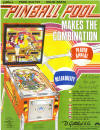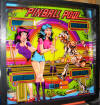|
This page includes info regarding my 1979 Gottlieb
Pinball Pool Pinball game. I bought this game in March of 2007 for $450 from a
local person here in Denver, Colorado who had the game stored in a
"porch" that was enclosed, but not heated. When I first saw the
game, it was standing on end and the game box didn't look that bad.
From what I could see of the playfield, it had some wear around the
lower multiplier inserts and a couple others above that, but other than
these wear problems, everything else looked dirty, but fine.
I offered the guy $450 for the game and wish I could have
given him more since he was a nice guy, but the game simply wouldn't be
worth much more than that price since it didn't work, needed repairs,
probably a new CPU board, and a serious cleaning. There was lots of what I would describe as
"mud" on the playfield glass and it took quite a while to get this
cleaned up. The "mud" had also made it to the underside
of the playfield glass
and was covering some of the playfield. The
light was low where I was viewing the game, and although the backbox
glass artwork looked pretty good, it turned out that once I got the game
home, spent more time removing the "mud," and looked at it a little closer,
there was more flaking than what I first thought. Not a lot of
flaking, but more than no flaking. The backside of the backglass had what appeared
to be "mud" on it too. I removed the glass before moving the game
downstairs to the main game storage area, and very lightly used a wet
rag to dab at the mud where no flaking appeared (when seen from the
front-side of the backglass) to remove it. I got most of the dirt off of
it, but there were some places where the artwork was lifting. Not
just a little lifting, but in one place around several inches square.
Per the usual Gottlieb games of this era, the flesh, red, and purple
colors had small flecks also missing. I shot the backside of the
backbox glass with Krylon triple-thick several times to keep it from getting any
worse. At least the glass could be handled without worrying about
further deterioration.
Once I lifted the playfield, I was pleasantly surprised to see
the original manual (that also included the schematic) still in the
game. The
underside of the playfield and inside the cabinet looked quite clean
which was surprising since there seemed to be so much "mud" on the
playfield glass as well as the playfield and backbox glass.
I cleaned all of this up, vacuumed out the game, polished
the rather nice legs that came with the game, and then moved it
downstairs. The targets on the game were mostly there, but someone
had replaced a few with other targets that didn't match the game. I bought new ones from Steve Young at PBR since new ones
always look so much nicer.
I met a new pinhead and nice guy named Abrie in early
2008, and he was
interested in watching a Stevebo shop job, so I told him we should
restore my Pinball Pool so he could learn about what goes in to
shopping a game. He came over in April of 2008 and he stripped down one side
of the playfield and I did the other. All parts from the top of
the playfield were thrown in a bowl for polishing later in a Berry
tumbler, and the underside screws that were removed were thrown in a
magnetic bowl for later cleaning as well. All coil springs, smaller
metal parts, screws, rollover switch wires, wireforms, pop bumper light
bulb sockets, and basically any metal
removed from the upper and lower playfield small enough to fit in the tumbler will be cleaned as well.
Abrie also helped re-target one of the target banks (yikes, lots of
targets on this game!), added new coil sleeves, replace the pop bumpers
after cleaning, shoped the flippers, magic erasered the playfield. After
meeting Abrie and spending time shopping my game, we ended up doing a
couple more games including one of his games (Secret Service). We've
stayed in touch and I consider Abrie to be a good friend.
Note: I ended up selling this Pinball Pool for $1200 because I
bought a HUO Pinball Pool from Kim Mitchell in April of 2009. Kim's game
was beyond HUO. It had literally come out of the box to be set up.
Required a new set of boards due to battery corrosion, but Kim bought a
Pascal Janin board for the game and I really made out on the game.
(click picture to enlarge)

Pinball Pool Flyer
 |
|
| Center captive ball area. |
|
 |
 |
Left center side of the
playfield.
Note the wear on the rack. |
Right center area of the
playfield.
|
 |
 |
| Right slingshot area. |
Rack area showing wear. |
 |
 |
| Center area with plastics
removed. |
Left target bank area with
plastics removed. |
 |
 |
Upper left area with
plastics removed.
Note the kickout wear. |
Upper right area with
plastics removed.
Kickout wear on this side too. |
 |
 |
Lower playfield area with
no plastics or apron. |
Left flipper area with
plastics removed.
|
 |
 |
| Upper left area, no
plastics. |
Center lane area, no
plastics. |
 |
|
| Ball trough area, plastics
removed. |
|
 |
 |
| Playfield stripped, center
area. |
Playfield stripped, center
left area. |
 |
 |
Playfield stripped, pop
bumper area.
|
Long view of stripped
playfield.
Only thing left to do is
remove both target banks. |
 |
 |
Underside view showing the
flippers
with only the ball eject removed. |
Another view of the
underside
of the playfield near the slingshots. |
 |
 |
Underside of playfield
showing pop bumper area.
|
Pop bumper light bulb
wires
before desoldering.
|
 |
 |
| Upper left kickout
mechanism. |
Upper right kickout
mechanism. |
 |
 |
Lower underside of
playfield
showing slingshots removed. |
Both pop bumpers removed
from underside of playfield. |
 |
 |
Left flipper view from the
underside of the playfield. |
Right flipper view from
the
underside of the playfield. |
 |
 |
Finished upper
playfield.
|
Finished upper left
playfield.
|
 |
 |
Finished right target
bank.
|
Finished left target bank.
|
 |
 |
Finished lower playfield.
|
Finished eight ball area.
|
 |
|
Backglass
|
|
|
All
Graphics & Text © Steve Corley |
|
The
pictures you see were created by Steve Corley unless otherwise
noted.
Unauthorized use is strictly prohibited |
|
